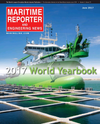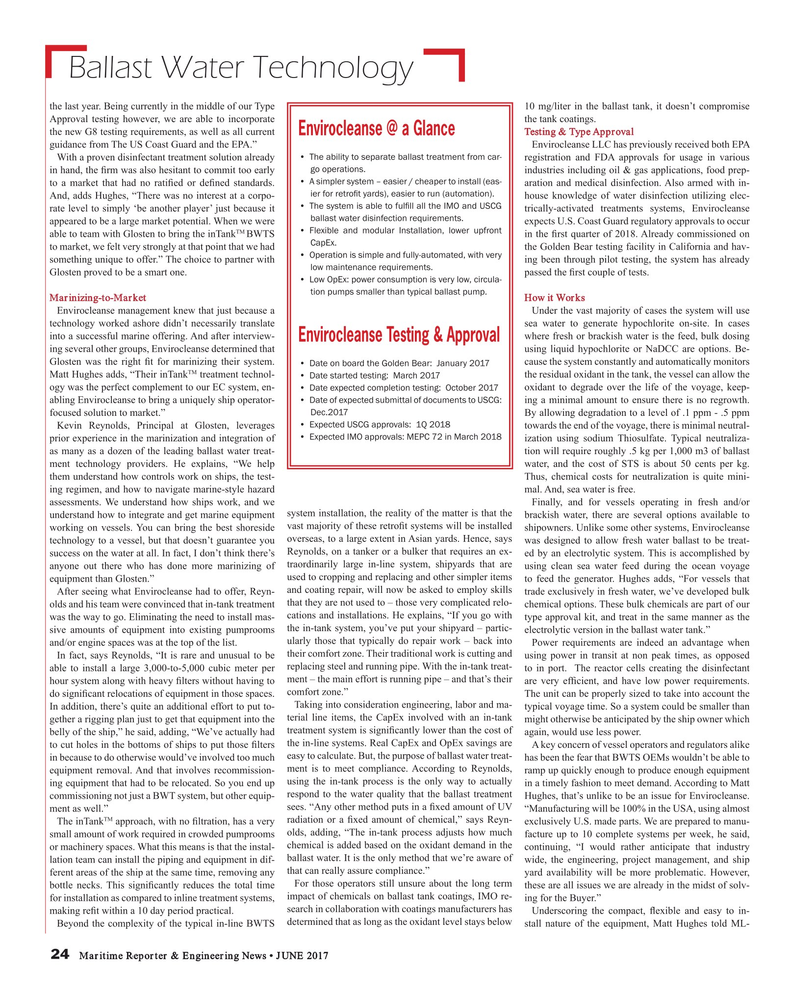
Page 24: of Maritime Reporter Magazine (June 2017)
U.S. Navy Quarterly
Read this page in Pdf, Flash or Html5 edition of June 2017 Maritime Reporter Magazine
Ballast Water Technology the last year. Being currently in the middle of our Type 10 mg/liter in the ballast tank, it doesn’t compromise
Approval testing however, we are able to incorporate the tank coatings.
the new G8 testing requirements, as well as all current Testing & Type Approval
Envirocleanse @ a Glance guidance from The US Coast Guard and the EPA.” Envirocleanse LLC has previously received both EPA • The ability to separate ballast treatment from car-
With a proven disinfectant treatment solution already registration and FDA approvals for usage in various go operations. in hand, the ? rm was also hesitant to commit too early industries including oil & gas applications, food prep- • A simpler system – easier / cheaper to install (eas- to a market that had no rati? ed or de? ned standards. aration and medical disinfection. Also armed with in- ier for retro? t yards), easier to run (automation).
And, adds Hughes, “There was no interest at a corpo- house knowledge of water disinfection utilizing elec- • The system is able to ful? ll all the IMO and USCG rate level to simply ‘be another player’ just because it trically-activated treatments systems, Envirocleanse ballast water disinfection requirements.
appeared to be a large market potential. When we were expects U.S. Coast Guard regulatory approvals to occur • Flexible and modular Installation, lower upfront
TM able to team with Glosten to bring the inTank BWTS in the ? rst quarter of 2018. Already commissioned on
CapEx.
to market, we felt very strongly at that point that we had the Golden Bear testing facility in California and hav- • Operation is simple and fully-automated, with very something unique to offer.” The choice to partner with ing been through pilot testing, the system has already low maintenance requirements.
Glosten proved to be a smart one. passed the ? rst couple of tests.
• Low OpEx: power consumption is very low, circula- tion pumps smaller than typical ballast pump.
Marinizing-to-Market How it Works
Envirocleanse management knew that just because a Under the vast majority of cases the system will use technology worked ashore didn’t necessarily translate sea water to generate hypochlorite on-site. In cases into a successful marine offering. And after interview- where fresh or brackish water is the feed, bulk dosing
Envirocleanse Testing & Approval ing several other groups, Envirocleanse determined that using liquid hypochlorite or NaDCC are options. Be-
Glosten was the right ? t for marinizing their system. cause the system constantly and automatically monitors • Date on board the Golden Bear: January 2017
TM
Matt Hughes adds, “Their inTank treatment technol- the residual oxidant in the tank, the vessel can allow the • Date started testing: March 2017 ogy was the perfect complement to our EC system, en- oxidant to degrade over the life of the voyage, keep- • Date expected completion testing: October 2017 • Date of expected submittal of documents to USCG: abling Envirocleanse to bring a uniquely ship operator- ing a minimal amount to ensure there is no regrowth.
Dec.2017 focused solution to market.” By allowing degradation to a level of .1 ppm - .5 ppm • Expected USCG approvals: 1Q 2018
Kevin Reynolds, Principal at Glosten, leverages towards the end of the voyage, there is minimal neutral- • Expected IMO approvals: MEPC 72 in March 2018 prior experience in the marinization and integration of ization using sodium Thiosulfate. Typical neutraliza- as many as a dozen of the leading ballast water treat- tion will require roughly .5 kg per 1,000 m3 of ballast ment technology providers. He explains, “We help water, and the cost of STS is about 50 cents per kg. them understand how controls work on ships, the test- Thus, chemical costs for neutralization is quite mini- ing regimen, and how to navigate marine-style hazard mal. And, sea water is free.
assessments. We understand how ships work, and we Finally, and for vessels operating in fresh and/or understand how to integrate and get marine equipment system installation, the reality of the matter is that the brackish water, there are several options available to working on vessels. You can bring the best shoreside vast majority of these retro? t systems will be installed shipowners. Unlike some other systems, Envirocleanse technology to a vessel, but that doesn’t guarantee you overseas, to a large extent in Asian yards. Hence, says was designed to allow fresh water ballast to be treat- success on the water at all. In fact, I don’t think there’s Reynolds, on a tanker or a bulker that requires an ex- ed by an electrolytic system. This is accomplished by anyone out there who has done more marinizing of traordinarily large in-line system, shipyards that are using clean sea water feed during the ocean voyage equipment than Glosten.” used to cropping and replacing and other simpler items to feed the generator. Hughes adds, “For vessels that
After seeing what Envirocleanse had to offer, Reyn- and coating repair, will now be asked to employ skills trade exclusively in fresh water, we’ve developed bulk that they are not used to – those very complicated relo- olds and his team were convinced that in-tank treatment chemical options. These bulk chemicals are part of our was the way to go. Eliminating the need to install mas- cations and installations. He explains, “If you go with type approval kit, and treat in the same manner as the sive amounts of equipment into existing pumprooms the in-tank system, you’ve put your shipyard – partic- electrolytic version in the ballast water tank.” ularly those that typically do repair work – back into and/or engine spaces was at the top of the list. Power requirements are indeed an advantage when
In fact, says Reynolds, “It is rare and unusual to be their comfort zone. Their traditional work is cutting and using power in transit at non peak times, as opposed able to install a large 3,000-to-5,000 cubic meter per replacing steel and running pipe. With the in-tank treat- to in port. The reactor cells creating the disinfectant hour system along with heavy ? lters without having to ment – the main effort is running pipe – and that’s their are very ef? cient, and have low power requirements. do signi? cant relocations of equipment in those spaces. comfort zone.”
The unit can be properly sized to take into account the
Taking into consideration engineering, labor and ma-
In addition, there’s quite an additional effort to put to- typical voyage time. So a system could be smaller than gether a rigging plan just to get that equipment into the terial line items, the CapEx involved with an in-tank might otherwise be anticipated by the ship owner which belly of the ship,” he said, adding, “We’ve actually had treatment system is signi? cantly lower than the cost of again, would use less power.
to cut holes in the bottoms of ships to put those ? lters the in-line systems. Real CapEx and OpEx savings are
A key concern of vessel operators and regulators alike easy to calculate. But, the purpose of ballast water treat- in because to do otherwise would’ve involved too much has been the fear that BWTS OEMs wouldn’t be able to equipment removal. And that involves recommission- ment is to meet compliance. According to Reynolds, ramp up quickly enough to produce enough equipment ing equipment that had to be relocated. So you end up using the in-tank process is the only way to actually in a timely fashion to meet demand. According to Matt commissioning not just a BWT system, but other equip- respond to the water quality that the ballast treatment Hughes, that’s unlike to be an issue for Envirocleanse. ment as well.” sees. “Any other method puts in a ? xed amount of UV “Manufacturing will be 100% in the USA, using almost
TM
The inTank approach, with no ? ltration, has a very radiation or a ? xed amount of chemical,” says Reyn- exclusively U.S. made parts. We are prepared to manu- small amount of work required in crowded pumprooms olds, adding, “The in-tank process adjusts how much facture up to 10 complete systems per week, he said, or machinery spaces. What this means is that the instal- chemical is added based on the oxidant demand in the continuing, “I would rather anticipate that industry lation team can install the piping and equipment in dif- ballast water. It is the only method that we’re aware of wide, the engineering, project management, and ship ferent areas of the ship at the same time, removing any that can really assure compliance.” yard availability will be more problematic. However, bottle necks. This signi? cantly reduces the total time For those operators still unsure about the long term these are all issues we are already in the midst of solv- impact of chemicals on ballast tank coatings, IMO re- for installation as compared to inline treatment systems, ing for the Buyer.” search in collaboration with coatings manufacturers has making re? t within a 10 day period practical. Underscoring the compact, ? exible and easy to in-
Beyond the complexity of the typical in-line BWTS determined that as long as the oxidant level stays below stall nature of the equipment, Matt Hughes told ML- 24 Maritime Reporter & Engineering News • JUNE 2017
MR #6 (18-25).indd 24 MR #6 (18-25).indd 24 6/7/2017 10:42:24 AM6/7/2017 10:42:24 AM

 23
23

 25
25
